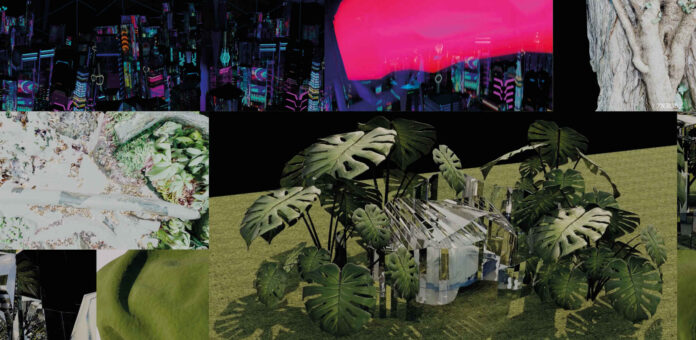As part of the »more than human«–project, the concept of the “Kunst- und Wunderkammer” is to be reactivated in order to recontextualise objects from the collections of the Kunstgewerbemuseum with contemporary design and art projects, prototypes and other artefacts.
The intervention “Wunderkammer” serves as an experimental space: By focussing on current topics such as biodiversity, ecology and the post-Anthropocene, visitors’ critical attention will be stimulated to reflect on and re-explore the multi-layered, interwoven relationships between humans, non-human actors and the environment.
In the second edition of the Wunderkammer two projects are shown.
Tales of Nature
Students of the Class of Spatial Design and Exhibition Design, Institute for Transmedia Design, Visual Communication course at Berlin University of the Arts have explored the question of how interrelated networks and relationships between humans, animals, plants and the material environment can emerge.
Based on an expanded understanding and investigation of matter, e.g. rocks and minerals, students visualised hidden stories and phenomena that were translated into fictional and narrative spatial scenarios in interaction with hybrid materialities. Visualisations, animations, experimental collages, 3D scans and sculptural material experiments open up digital spaces and unknown imaginary worlds that tell of undiscovered materialities, bodies and places.
With projects by: Florentin Aisslinger, Fiona Belousz, Maria Capello, Vincent Carter, Mattia Friso, Ernst August Graefe, Lukas Graf, Hannah Greifenstein, Valentin Jauch, Shinae Kim, Livia Kirchner, Jason Kittner, Maria Kobylenko, Stefanie Messner, Boohri Park, Jil Schuberth, Klara Troost, Pauline Luca Wunderlich
Artistic collaborator, until 2024: Ruven Wiegert
Head: Prof. Gabi Schillig
More-Than-Human Sketching
The section More-Than-Human Sketching exhibits the results of a participative design anthropology research process, which centers around the repurposing of an emerging digital design tool, 3D drawing, to delve into the collections of the Kunstgewerbemuseum through collective acts of spatial sketching. Building upon the ongoing experiments in digital anatomical training currently under development at the Speculative Realities Lab (Cluster of Excellence »Matters of Activity« / Department for Neurosurgery, Charité), researchers and workshop participants engaged in co-designing interactive augmented performances. Together, they created new scores to immerse themselves in the more-than-human crafting processes embedded within the collection objects.
Sketching has long been the mark of the designerly knowing. At the core of the modern forming process, there is a mysterious act that partly evades the maker’s intentions: when hand, paper, and idea meet, an intuitive digestion of spatial knowledge happens through quasi-conscious gestures. Like the motile fingers of mycelium networks growing through their environment, these lines embrace forms, making sense of their relations.
What if design and humanities could ally to imagine new visual and performative arguments to counteract the anthropocentric views on material cultures and biomedical visual knowledge? In the four vitrines of the Wunderkammer, colorful graphic ethnographic field notes display how groups of visitors sketched in 3D following these performative scores, while embracing a new perspective on the activity of materials. Along with the images, 3D prints of the objects in various materials (resin, clay) stand in the place of the museum objects that were sketched and digitally “digested” by the participants.
Project team: Maxime Le Calvé, Elaine Bonavia, Greta Stefanovic, Nayeli Vega, Kotryna Slapsinskaite
A special exhibition of the Kunstgewerbemuseum – Staatliche Museen zu Berlin
Source : Museen zu Berlin












